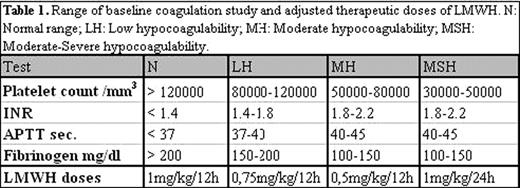Abstract
Abstract 3358
Non-neoplastic chronic portal vein thrombosis (PVT) is a frecuent diagnosis in the course of liver cirrhosis, with reported prevalences of 0.6% to 15,8%. PVT can motivate life-threatening complications due to worsening portal hypertension, so anticoagulation therapy is challenging in these patients.
To analyze the response to antithrombotic therapy and changes in liver function tests in 28 patients with chronic PVT associated with cirrhosis.
28 consecutive patients with liver cirrhosis and chronic PVT were treated with antithrombotic therapy from 2004 to 2009. Hepatocellular carcinoma and known thrombophilic risks were ruled out. Therapy consisted in 15 days of therapeutic doses of low molecular weight heparin (LMWH) (enoxaparin) adjusted according to baseline coagulability (Table 1 ), followed by either prophylactic doses (40mg/day) of LMWH or acenocoumarol (target INR 2–3), during 6 months. Response was evaluated after 6 months. If recanalization was complete, therapy was suspended. If recanalization was partial or no recanalization was observed, therapy was continued until response.
From the 28 patients studied, 19 (68%) were males with a median age of 53 years (range 35–77). Cirrhosis was due to alcoholism (25%), virus (54%), mixed in 1 patient and other causes in 3 patients. PVT involved the portal trunk and/or branches in 19/28 (68%) patients, mesenteric vein in 2 patients and portal trunk and/or branches, mesenteric and/or splenic vein thrombosis coexisted in 7 patients. 19/28 (68%) of the patients had moderate or moderate-severe hypocoagulability range. Complete and partial thrombosis was seen in 18 and 10 patients at diagnosis, respectively. From the 28 patients, 18 (64%) responded to antithrombotic therapy after 6 months, with a complete recanalization in 13 patients 13/18 (72%) and partial in 5/18 patients (28%). None of the 28 patients presented hemorrhagic complications and none showed platelets counts below baseline values. 17 from the 18 patients who responded, showed altered liver function tests before therapy. After 6 months, 8/17 (47%) improved liver function (only one patient had received antiviral therapy). After a median follow up of 42 months (range 7–67), 15/18 (83%) patients continued showing complete or partial response while 3 patients progressed. Of note, 3 patients of this group could proceed to further liver transplantation.
Antithrombotic therapy in chronic PVT in cirrhotic patients resulted in a high response rate (64%) in our study, with a complete recanalization in 72% of the cases. Adjusted dose scheme according to level of hypocoagulability seems to be effective and safe, since 63% of the subgroups of moderate and moderate-severe hypocoagulability responded with no haemorrhagic complications.
No relevant conflicts of interest to declare.
Author notes
Asterisk with author names denotes non-ASH members.


This feature is available to Subscribers Only
Sign In or Create an Account Close Modal